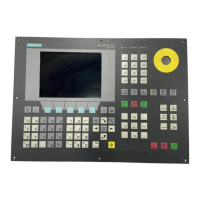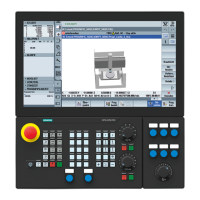Table of contents
Job planning
10 Programming Manual, 07/2010, 6FC5398-2BP40-0BA0
5.2.2 Reading and changing frame components (TR, FI, RT, SC, MI).............................................. 290
5.2.3 Linking complete frames ........................................................................................................... 291
5.2.4 Defining new frames (DEF FRAME) ......................................................................................... 292
5.3 Coarse and fine offsets (CFINE, CTRANS).............................................................................. 293
5.4 External zero offset ................................................................................................................... 295
5.5 Preset offset (PRESETON)....................................................................................................... 296
5.6 Frame calculation from three measuring points in space (MEAFRAME) ................................. 298
5.7 NCU global frames.................................................................................................................... 302
5.7.1 Channel-specific frames ($P_CHBFR, $P_UBFR) ................................................................... 303
5.7.2 Frames active in the channel .................................................................................................... 304
6 Transformations..................................................................................................................................... 309
6.1 General programming of transformation types ......................................................................... 309
6.1.1 Orientation movements for transformations.............................................................................. 312
6.1.2 Overview of orientation transformation TRAORI....................................................................... 315
6.2 Three, four and five axis transformation (TRAORI) .................................................................. 317
6.2.1 General relationships of universal tool head............................................................................. 317
6.2.2 Three, four and five axis transformation (TRAORI) .................................................................. 320
6.2.3 Variants of orientation programming and initial setting (ORIRESET)....................................... 322
6.2.4 Programming of the tool orientation (A..., B..., C..., LEAD, TILT) ............................................. 323
6.2.5 Face milling (3D-milling A4, B4, C4, A5, B5, C5)...................................................................... 330
6.2.6 Orientation axis reference (ORIWKS, ORIMKS)....................................................................... 331
6.2.7 Programming orientation axes (ORIAXES, ORIVECT, ORIEULER, ORIRPY, ORIRPY2,
ORIVIRT1, ORIVIRT2)..............................................................................................................
333
6.2.8 Orientation programming along the peripheral surface of a taper (ORIPLANE,
ORICONCW, ORICONCCW, ORICONTO, ORICONIO)..........................................................
336
6.2.9 Specification of orientation for two contact points (ORICURVE, PO[XH]=, PO[YH]=,
PO[ZH]=) ...................................................................................................................................
340
6.3 Orientation polynomials (PO[angle], PO[coordinate])............................................................... 342
6.4 Rotations of the tool orientation (ORIROTA, ORIROTR, ORIROTT, ORIROTC, THETA)....... 344
6.5 Orientations relative to the path ................................................................................................ 347
6.5.1 Orientation types relative to the path ........................................................................................ 347
6.5.2 Rotation of the tool orientation relative to the path (ORIPATH, ORIPATHS, angle of
rotation) .....................................................................................................................................
349
6.5.3 Interpolation of the tool rotation relative to the path (ORIROTC, THETA)................................ 350
6.5.4 Smoothing of orientation characteristic (ORIPATHS A8=, B8=, C8=) ...................................... 352
6.6 Compression of the orientation (COMPON, COMPCURV, COMPCAD).................................. 354
6.7 Smoothing the orientation characteristic (ORISON, ORISOF) ................................................. 358
6.8 Kinematic transformation .......................................................................................................... 360
6.8.1 Milling on turned parts (TRANSMIT)......................................................................................... 360
6.8.2 Cylinder surface transformation (TRACYL) .............................................................................. 363
6.8.3 Inclined axis (TRAANG)............................................................................................................ 372
6.8.4 Inclined axis programming (G05, G07)..................................................................................... 375
6.9 Cartesian PTP travel ................................................................................................................. 377
6.9.1 PTP for TRANSMIT................................................................................................................... 381
6.10 Constraints when selecting a transformation............................................................................ 385
6.11 Deselect transformation (TRAFOOF) ....................................................................................... 386

